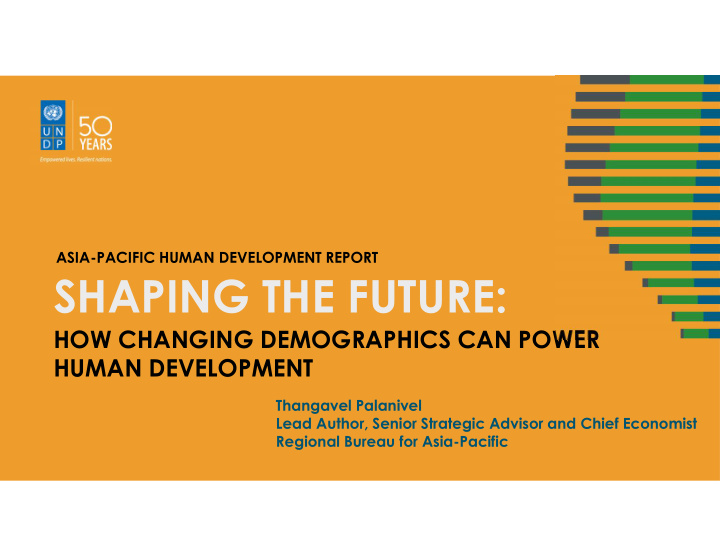



ASIA-PACIFIC HUMAN DEVELOPMENT REPORT SHAPING THE FUTURE: HOW CHANGING DEMOGRAPHICS CAN POWER HUMAN DEVELOPMENT Thangavel Palanivel Lead Author, Senior Strategic Advisor and Chief Economist Regional Bureau for Asia-Pacific
P OPULATION SHARES SHIFTING RAPIDLY IN A SIA -P ACIFIC 100 80 60 % 40 20 0 1950 1975 2000 2025 2050 2075 2100 Children (0-14) Youth (15-24) Working (25-59) Old (60+)
D EMOGRAPHIC TRANSITION : THREE GROUPS OF COUNTRIES I NITIAL STAGE M IDDLE STAGE A DVANCED STAGE Median age below 23 Median age between 23-35 Median age above 35 Afghanistan Nepal China Timor-Leste Cambodia Australia Solomon Islands Philippines Macao, China (SAR) Samoa Bangladesh New Zealand Papua New Guinea Maldives Thailand Tonga India Taiwan Province of China Micronesia (Fed. States of) Bhutan Singapore Lao PDR Mongolia Korea (Republic of) Vanuatu Fiji Hong Kong, China (SAR) Kiribati Myanmar Japan Pakistan Indonesia Malaysia Iran (Islamic Rep. of) Viet Nam Brunei Darussalam Sri Lanka DPR Korea
D EMOGRAPHIC DIVIDEND PLAYED A KEY ROLE IN E AST A SIA ’ S MIRACLE In East Asia, 25-40 percent of per capita GDP growth since 1965 comes from demographic dividend. Demographic dividend is not an automatic process It requires a long-term vision, strategic policies and good governance.
M ORE FUNDAMENTAL RETHINKING IS NEEDED Integrate demographic changes into national development plans and strategies Collect more and better data on youth and ageing Improve regional cooperation and integration
COUNTRIES IN EARLY TRANSITION: UNLOCKING THE POTENTIALS OF THE NEXT GENERATION
A CTION 1: P ROVIDE BETTER EDUCATION AND S KILLS Scale up secondary and tertiary education Ensure quality of education at all level Increase in public investments in education
A CTION 2: S MOOTH THE TRANSITION FROM SCHOOL TO WORK Expand opportunities for technical education and vocational training Support Youth Entrepreneurship
A CTION 3: E NCOURAGE YOUTH PARTICIPATION Cultivate youth volunteerism Bring youth in policy dialogues
COUNTRIES IN MIDDLE TRANSITION: MAKING THE MOST OF DEMOGRAPHIC OPORTUNTIES
A CTION 4: C REATE MORE AND BETTER JOBS Design employment oriented growth strategy Identify and promote labour-intensive industries Support SMEs Link wages with productivity growth
A CTION 5: A CHIEVE WOMEN ’ S EQUAL PARTICIPATION Reduce gap male-female labour force participation rate Provide flexible employment options Develop reliable and cost-effective childcare services Ensure equal pay Provide safe work environment.
A CTION 6: M OBILIZE SAVINGS AND CHANNEL THEM INTO PRODUCTIVE SECTORS Promote inclusive financial sector Strengthen domestic financial instruments Deepen regional financial integration
IN ADVANCED TRANSITION: WITH EARLY PLANNING, COUNTRIES CAN SMOOTH THE PROCESS OF AGEING.
A CTION 7: I MPROVE NATIONAL PENSION SYSTEMS Increase coverage, adequacy and sustainability Tackle poverty among the elderly Promote traditional family support
A CTION 8: E XPAND HEALTHCARE SYSTEMS FOR OLDER PEOPLE Move towards to universal healthcare Expand long-term (NCD) care facilities Make health care affordable and accessible
A CTION 9: S UPPORT ACTIVE AGEING Increase the retirement age and provide flexible employment options Involve older people in the decision making process Improve infrastructure to support independent living Tackle negative perception about ageing
REALIZING THE FULL POTENTIAL OF URBANISATION. IF THE PROCESS IS WELL-MANAGED, CITIES CAN BOOST HUMAN DEVELOPMENT AND THE DEMOGRAPHIC DIVIDEND.
P OLICY AGENDA TO MAKE CITIES MORE INCLUSIVE , SUSTAINABLE AND COMPETITIVE Manage cities more effectively. Make cities more inclusive. Develop modern, environmentally friendly cities
THE REPORT CALLS FOR IMMEDIATE RESPONSE FOR IMPLEMENTING THE 9 ACTIONS FOR SUSTAINABLE DEVELOPMENT. THE TIME TO ACT IS NOW! IF WE DON’T, WE’LL LOSE THIS UNIQUE OPPORTUNITY.
For more details, visit http://www.asia-pacific.undp.org/content/rbap/en/home/hdr.html
Recommend
More recommend